Knee osteoarthritis is a retrograde condition affecting the function of the knees. It is caused by damage and deformation of the joint’s articular cartilage, and is tied to age and endocrine disorders. Trauma, poor posture and hereditary factors also play roles in the condition.
In TCM, Knee osteoarthritis is a type of bone bì syndrome. As the kidney is the foundation of the congenital constitution and governs the bone, Osteoarthritis is often related to kidney and liver deficiency, weak constitutions, and stagnation of qi and blood. Attacks by wind-damp combined with cold or heat can obstruct qi and blood in the channels and collaterals. If this lasts for a long time, it can consume healthy qi while the pathogenic qi becomes stronger.
Clinical manifestations of knee osteoarthritis
- Pain or stiffness of the knee. The pain is obvious when walking or climbing stairs.
- Swelling and limited movement of the knee. The knee feels unstable when walking.
- Morning stiffness and heaviness of the knee joint.
- A sound is often audible when the knee is moved.
6 Acupuncture points for knee osteoarthritis
The basic therapeutic principles are to relax the sinews, quicken the collaterals, unblock the channels and relieve pain. Acupuncture and moxibustion are primarily used to relieve pain, improve function and delay the progression of the disease. According to the Yellow Emperor’s Internal Classic, “When [the disease is] in the bone, [choose acupoints that] govern the bones. When in the sinews, [choose acupoints that] govern the sinews.” In the clinic, local points and points along the channels that traverse the area of pain are mainly chosen for heat-sensitized exploration.
1. EX-LE4 Acupoint (Neixiyan)

Location: On the knee, in the depression between the patella and the medial side of the patellar ligament when the knee is bent.
Effect: Unblocks the collaterals, relieves pain, promotes joint function.
2. ST 35 Acupoint (Dubi)
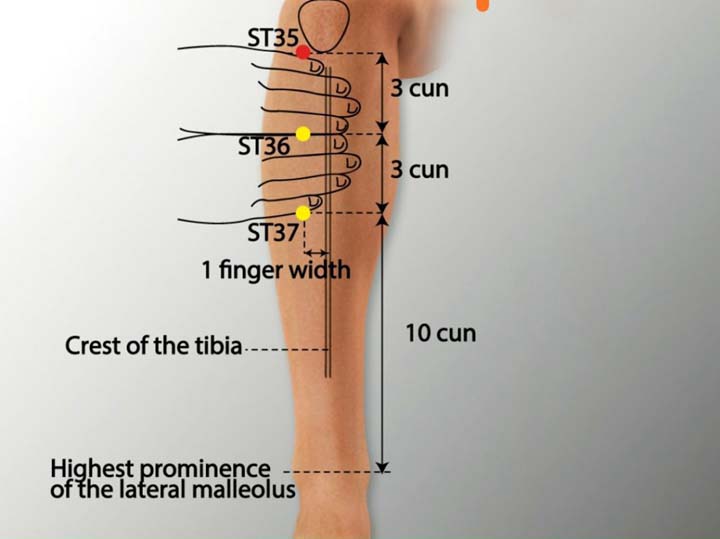
Location: On the knee, in the depression between the patella and the lateral side of the patellar ligament when the knee is bent.
Effect: Unblocks the collaterals, relieves pain, promotes joint function.
3. ST 34 Acupoint (Liangqiu)
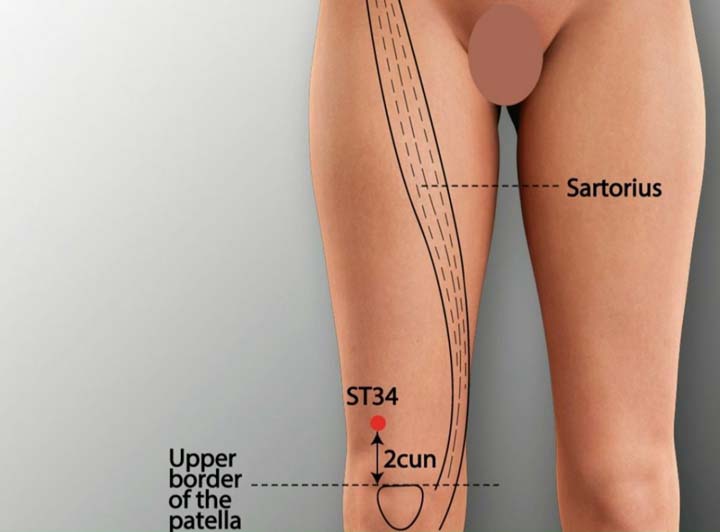
Location: On the anterior thigh, on the line connecting the anterior superior iliac spine and the lateral side of the base of the patella when the knee is bent, 2 cun above the base of the patella.
Effect: Dispels wind-damp, promotes the function of the knees, unblocks the collaterals, relieves pain.
4. SP 9 Acupoint (Yinlingquan)

Location: On the medial leg, in the depression posterior and inferior to the medial condyle of the tibia.
Effect: Dispels wind-damp, promotes the function of the knees, unblocks the collaterals, relieves pain.
5. SP 10 Acupoint (Xuehai)
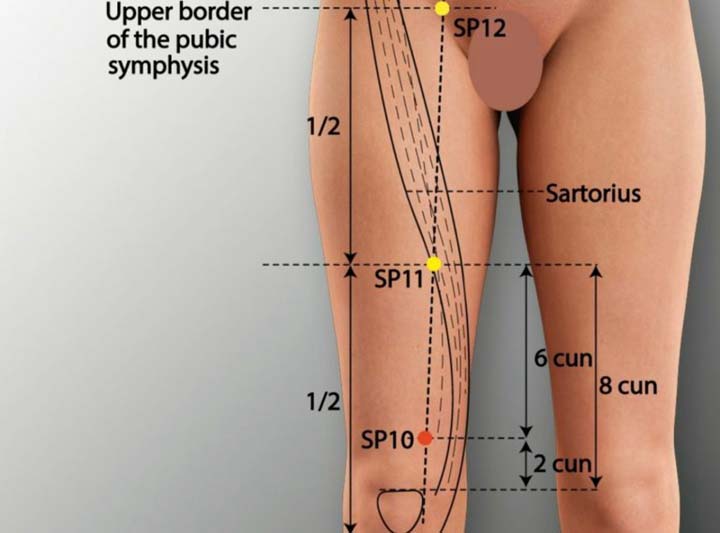
Location: On the medial thigh 2 cun superior to the medial side of the base of the patella, on the protuberance of the medial head of the quadriceps muscle.
Effect: Regulates blood, dispels stasis, unblocks the collaterals, relieves pain.
6. GB 34 Acupoint (Yanglingquan)
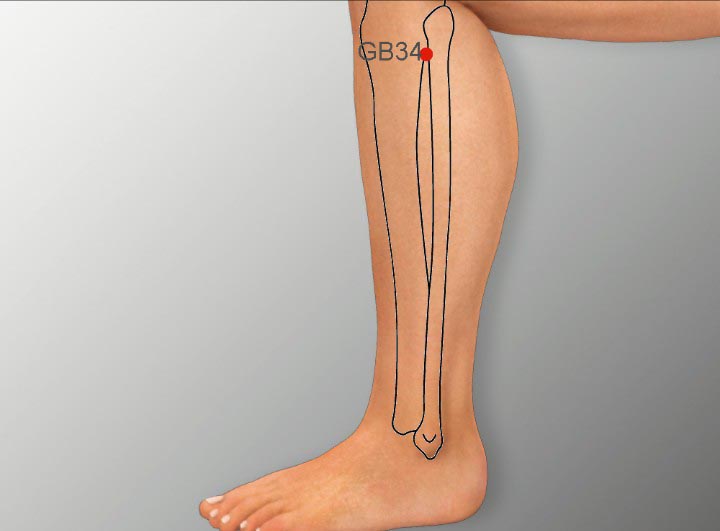
Location: On the lateral side of the lower leg, in the depression anterior-inferior to the head of the fibula.
Effect: Relaxes the sinews, unblocks the collaterals, promotes the function of the knees.
7. Tender points on the knees
Location: On the knees.
Effect: Unblocks the collaterals, relieves pain, promotes joint function.
Moxibustion treatment methods
- Double-point mild moxibustion on EX-LE4 and ST 35. The patient should feel the heat penetrate into the knee and expand over the joint. EX-LE4 and ST 35 are located at the base of the patella and can unblock the collaterals, relieve pain and promote joint function.
- Double-point mild moxibustion on ST 34 and SP 9. The patient should feel the heat penetrate into the knee and expand over the joint. ST 34 is the xi-cleft point of the stomach channel and SP 9 is the he-sea point of the spleen channel. The combination of these points can dispel wind-damp and promote the function of the knees.
- Double-point mild moxibustion on SP 10 and GB 34. The patient should feel the heat penetrate into the knee and expand over the joint. SP 10 can regulate blood, dispel stasis, unblock the collaterals and relieve pain, while GB 34 can relax the sinews, unblock the collaterals and promote the function of the knees.
- Mild moxibustion on tender points on the knees. The patient should feel the heat penetrate into the knee, expand over the entire joint, or feel local soreness, distention, and pain. Stop moxibustion when the heat-sensitized sensation disappears.
Treat once a day, choosing one or two groups of the above acupoints each time. Ten treatments make a treatment course. Give two or three courses in total, with two to five days in between for rest.
Conclusion
Moxibustion treats knee osteoarthritis through its ability to dredge the channels, move qi, reduce inflammation, ease pain and improve circulation.
Patients should be advised to keep their knees warm, exercise to improve their physiques, lose weight, and avoid walking or standing for long periods.

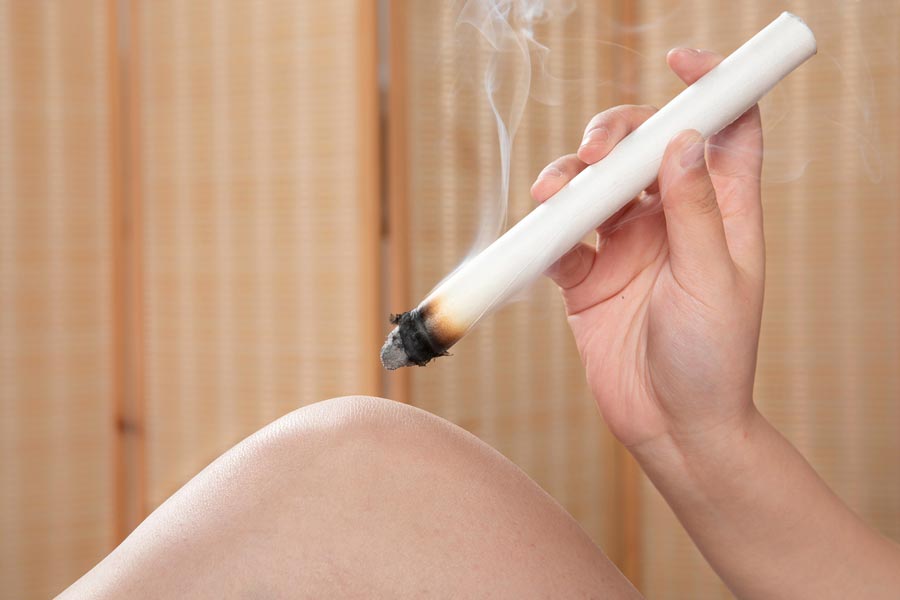
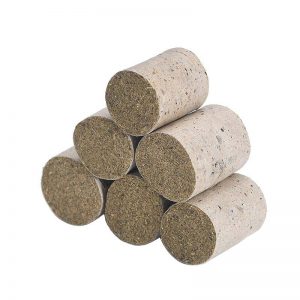
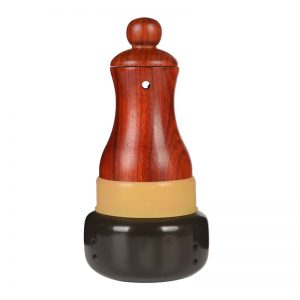
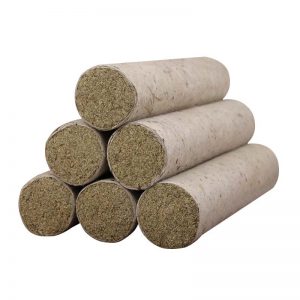
Thanks for the guide!